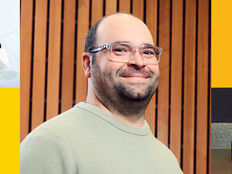Who's in Charge?
Juniata College empowers student IT managers to take control of budgets and staff — and make executive-level decisions
Two summers ago, Jigar Patel was hawking candy and popcorn at Hershey Park, a theme park and resort in Hershey, Pa. Now, he’s managing a $58,000-plus information technology budget and a staff of 15.
Patel hires, fires and trains employees at Juniata College in Huntingdon, Pa. He collaborates with professors on new education technology projects, runs the school’s computer media lab, and tests and purchases hardware and software for the campus.
At Juniata, students like Patel hold jobs that go way beyond the age-old work-study model. They’re high-level, paid entrepreneurs, controlling five-figure budgets, managing employees, and making executive-level decisions on everything from purchasing to new technology initiatives to hiring.
Student Majority
Two-thirds of the IT staff at Juniata College are student managers, who can work up to 17.5 hours a week at $5.15 an hour.
“When I talk to [potential] employers about the best of our students, I have to emphasize, ‘No, I’m not kidding,’ ” says Nathan Wagoner, Juniata’s instructional systems developer and director of the digital media unit. “This kid oversaw our network administrators, a budget of $30,000 and a staff of a dozen. I sometimes get off the phone wondering if they believed me.”
Hiring student managers is a win-win, explains CIO David Fusco. Students graduate with more than technical skills; they have sophisticated communications and management skills, as well. Employers get workers with the energy of young employees and the experience of seasoned veterans. And Juniata gets a committed staff.
“We get this enthusiastic fresh blood, and we get a new infusion every year,” Wagoner says. “This allows us to have a much larger dedicated workforce than we could possibly field otherwise.”
Technology is an ideal department for such an ambitious program because students are generally more tech-savvy than adults. “This kind of evolved out of recognition that our students were more comfortable with technology than most of our technology staff,” Wagoner explains.
Initially, it was hard for professionals at Juniata to follow the lead of students 20 or 30 years younger. The program has become ingrained in Juniata’s culture, though, in the eight years since its inception.
“If you bring students in at that level, they own it,” says Wagoner, who has been at Juniata for six years. “They care. They’re invested in the process, they’re invested in the organization and they’re invested in the end result.”
How IT Works
Students comprise about two-thirds of Juniata’s 60-person technology staff. They start on the help desk and can move on to higher-level positions. A handful of students are given budgetary access and management roles, explains CIO David Fusco.
Each of the student managers reports to a full-time employee. Their schedules are capped at 17.5 hours a week. They make $5.15 an hour during the academic year, but they work full time, earning $10 an hour, at least one summer.
Juniata gives its student managers a high degree of authority and autonomy. But Fusco and his team make sure students don’t get too carried away with their jobs. “They are here to be students first,” he says.
Each summer, Campus Technology Services holds a five-day boot camp, where student workers receive intensive training. By the end of their junior year, student managers start recruiting and training their replacements. That’s how senior Kyle McClure, digital video manager, honed his skills.
“There was so much to learn,” he says. “Basically, I learned from watching other students.”
The Real Real World
There is a downside to turning students into workplace leaders: “By the time they get really good, they graduate,” laments Fusco.
But the employers hiring Juniata grads aren’t complaining. Michael Patterson, president and CEO of Strong M, an RFID asset management firm in Columbus, Ohio, enlisted 2005 graduate Cody Boggs as his digital media director.
Boggs’ colleagues come from the Massachusetts Institute of Technology and Carnegie Mellon, from Microsoft and Oracle. “He just fit right in,” Patterson says of Boggs. With a budget just shy of $5 million, Boggs manages eight contractors and three in-house employees, and he hosts seven Web sites.
“Our policy here is to throw people in and see how much they can handle,” Patterson explains. “We have yet to overwhelm [Boggs]. He’s been able to handle an executive amount of responsibility.”
At 23, Boggs is still working toward his master’s degree in business administration, juggling multiple federal government projects and helping to launch a steady supply of new technology firms through Strong AI, the company’s incubation arm. In his free time, he and his Strong M colleagues do programming for Grassroots.org, which offers a free toolbox of applications for nonprofits.
The time management and project management skills he learned from Wagoner and Rob Yelnosky, Fusco’s predecessor, have been invaluable on the job, Boggs says.
“I was better prepared for the real world due to the program,” he explains. “The skills you get leading real projects for real customers go way beyond what you would learn from a textbook or a simulation.”
When Kyle McClure graduates this spring, he plans to look for a job doing essentially what he does now at Juniata; he manages a digital video unit that records and edits school productions and events.
Experiences such as producing high-quality marketing videos for the college and managing a $35,000 budget have given McClure the skills he knows will come in handy in the workforce.
“I’ve done the work before I’ve even graduated,” he says.
Young Entrepreneurs
As a freshman at Juniata, Laura Sweltz knew enough about technology to get by, but now and then she needed a helping hand with things like mapping a drive.
“I was one of those people who was constantly calling the help desk,” says Sweltz, an international studies and instructional design student. Now, a year later, not only does she know how to map her own drives, she helps students and professors throughout the campus with their technology challenges.
Sweltz, who was recruited by Patel to work on the help desk, has since been elevated to training manager. She oversees a technology training staff for employees and students. “I’ve learned so much about technology and management,” she says.
One of Patel’s goals this year is to hire students with a variety of majors so his department will be able to relate to a wide array of end users.
“Forget the technology,” Fusco says. “It’s so much easier to teach than people skills.”
By collaborating with such high-level officials as the college president or provost, Juniata students develop selfconfidence and communications skills, Wagoner points out. “The best students leave here with political know-how,” he says. “And that’s invaluable.”
Patel says he was shy when he started at Juniata, but managing the campus’ Teaching and Learning Technologies Center and working directly for the vice president of IT forced him to assert himself.
In addition to his job and classes, Patel is on the student government executive board and has an internship with the college marketing department. So time management has been an essential part of his college experience. Says Patel: “I’m learning not to goof off.”
CIO David Fusco on Helping Students Learn to Lead
- Bring student managers in early in their college career. They’ll have more time to become fully invested. They’ll care more.
- Forget technology: Look for energetic, smart students with “people skills” — that’s something you can’t teach.
- Encourage students to educate their less tech-savvy elders — both IT staff and faculty.
- Trust is essential. If you’re going to let them manage, don’t question their decisions.
- When there’s absolutely no room for error, send in your full-time staff.
- Be willing to let go. When your stars graduate and land great jobs, remember that there will always be fresh blood in your student body, just waiting to fill their shoes.
Can It Work Elsewhere?
Some college IT leaders have adopted the Juniata student-worker model for their own campuses after hearing about it at conferences, while others are stunned that students are given so much authority and trust.
Only about five or six of Juniata’s student workers are entrusted with truly high-level responsibility. Those students are carefully selected by CIO David Fusco and other department leaders. “We’re getting the best of the best,” Fusco says.
But the program requires an extraordinary leap of faith, says Nathan Wagoner, director of Juniata’s digital media unit. “You have to trust students,” he says. “And you have to be willing to give up a major piece of the pie.”
Students occasionally make mistakes, but none that have made Juniata rethink its model, Wagoner says. When there’s absolutely no room for error, the full-time staff takes control.
“Unless it’s radically off the mark, they never question the decisions we make,” says junior Jigar Patel, manager of Juniata’s Teaching and Learning Technologies Center. “That’s a real confidence booster that they trust you. It makes you want to do the best that you can.”
Work-study programs that don’t give students significant responsibility can easily “end up with unmotivated drones who are probably doing their homework,” Wagoner says. “My advice is to give away the store.”







